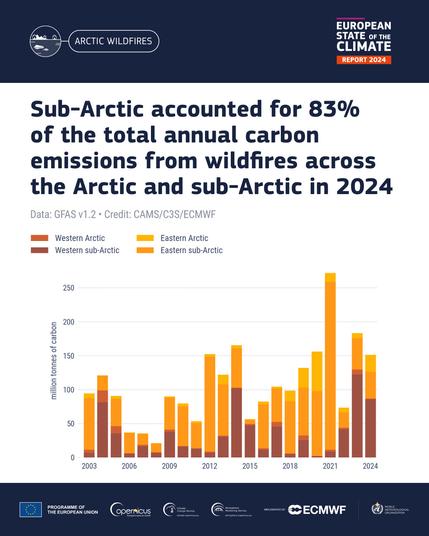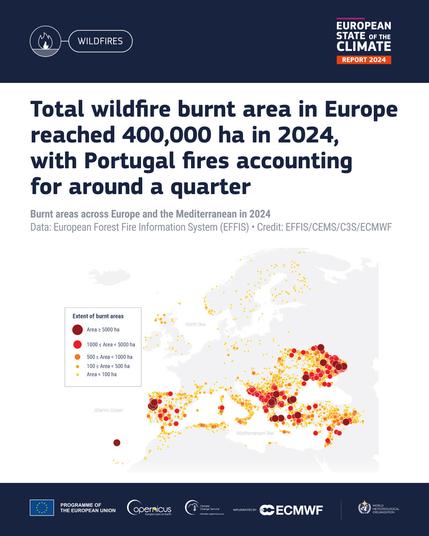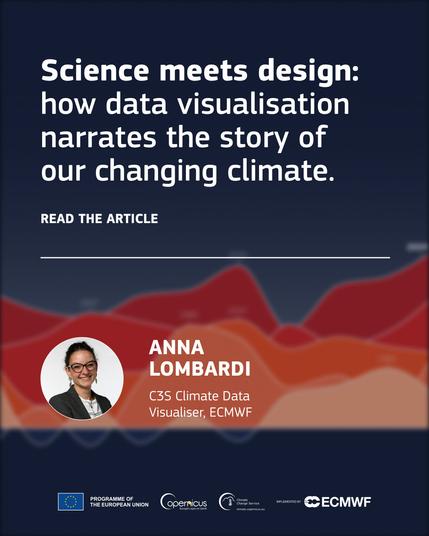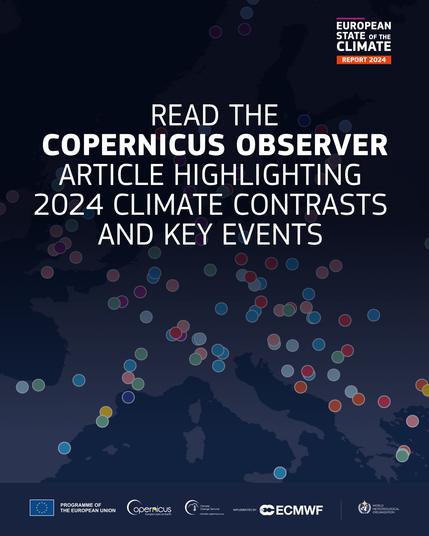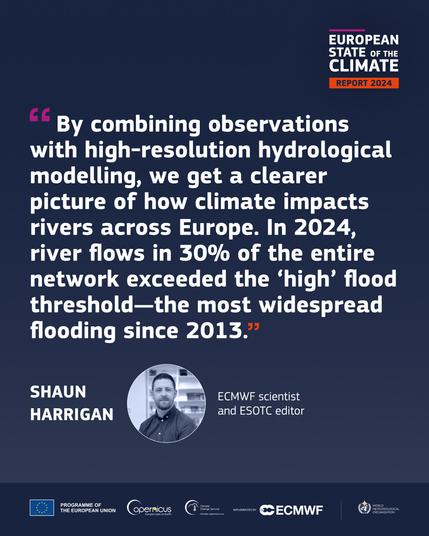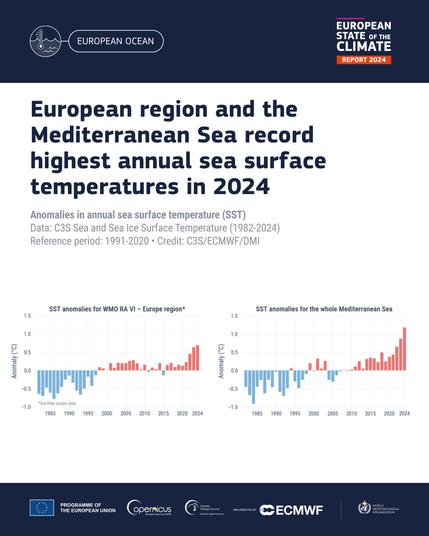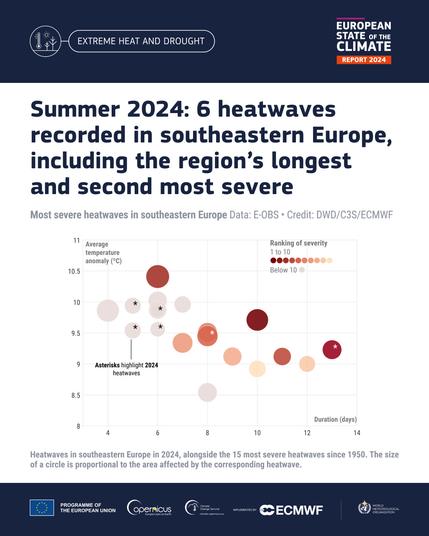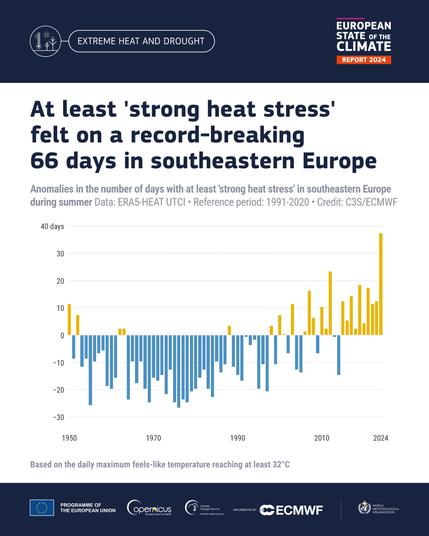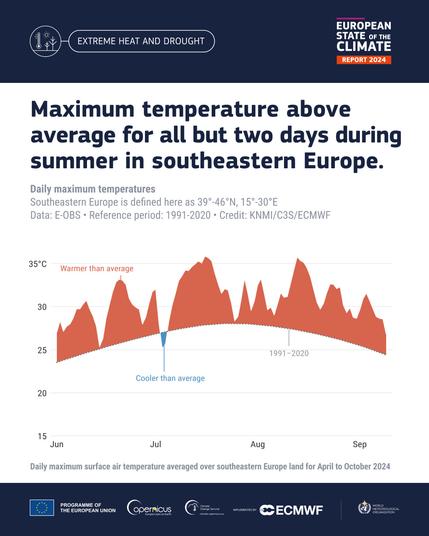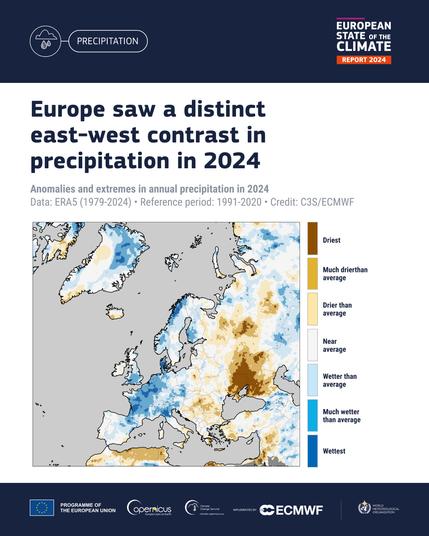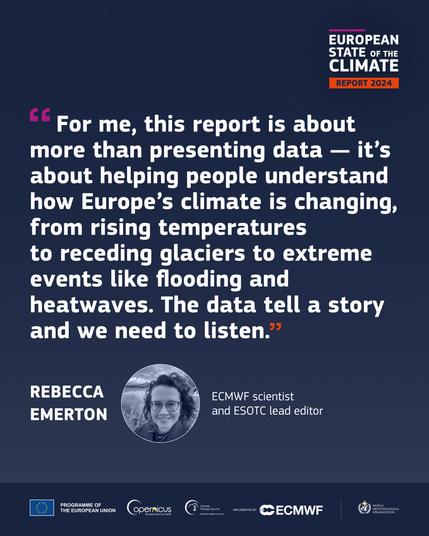In 2024, wildfire carbon emissions from high northern latitudes registered sixth highest in the 22-year satellite record. Wildfire carbon emissions from the sub-Arctic and Arctic regions reached an estimated 151 million tonnes, based on #CopernicusAtmosphere data, with most fires occurring in Canada’s Northwest Territories and Russia’s Sakha Republic.
https://bit.ly/4cqulS6
#ESOTC2024
Have you explored the insights of #ESOTC2024 yet? Our article guides you through the report section by section, providing a snapshot of key topics, climate contrasts and conditions impacting Europe and the Arctic in 2024. Read it now 👉 https://climate.copernicus.eu/esotc-2024-your-guide-europes-changing-climate?utm_source=socialmedia&utm_medium=ma&utm_campaign=esotc-2024-your-guide-europes-changing-climate
#C3S
In 2024, Europe saw average to slightly above-average fire danger for most of the year, with the highest values in September. Around 110,000 hectares burnt in Portugal that month, accounting for around a quarter of the overall total burnt area in Europe for the year. Get more insight 🔥 https://bit.ly/3RJqQwB
Our ECMWF colleague Dr Anna Lombardi speaks to the power of data visualisation in telling the story of our evolving climate. From her cover art based on decades of temperature data to 130+ charts, read how data was converted into easy-to-understand graphics in the #ESOTC2024.
https://climate.copernicus.eu/role-data-visualisation-european-state-climate-2024
❄️ In 2024, 69% of the continent experienced fewer than three months (90 days) of frost days – the largest area on record. Explore more on cold extremes in Europe in the joint #ESOTC2024 report by #C3S and WMO. https://bit.ly/3YsEw2N
In 2024, northern Europe saw more snow days than average – up to 45 days at one location in Norway – while much of Europe experienced fewer days due to above-average winter temperatures. Negative anomalies ranged from -5 to -45 snow days, with the largest over southern Germany, southern Poland and the Balkans.
https://bit.ly/4jwWxoX
#ESOTC2024
However, it was reported to be a record year for additions to total EU solar PV capacity. This meant that, despite the below-average climate-driven potential for solar PV power generation, the year as a whole saw an increase in actual solar electricity generation compared to 2023. Details here https://bit.ly/4jkX39a #ESOTC2024 #C3S
In 2024, Europe experienced a distinct east-west contrast in river flow. Some rivers in the west, like the Thames and Loire, reached record highs, while eastern Europe faced lower-than-average river flows much of the year, with the lowest November flows on record.
#ESOTC2024 #C3S
Discover more about the contrasts in climate conditions revealed by #ESOTC2024 in the latest Copernicus OBSERVER article published by #copernicuseu Get insight into warmest year on record, including data on heatwaves, flooding, glacier melt and more. #C3S
https://www.copernicus.eu/it/node/84926
#ESOTC2024 not only provides detailed analyses of Europe's climate in 2024, it also summarises long-term trends in key Climate Indicators for the globe and Europe. These include temperature, sea level, glaciers, ocean heat content, greenhouse gases and more. Explore the Climate Indicators dashboard. https://bit.ly/3YutBph #C3S
Learn more about how climate conditions impacted rivers and flooding in Europe in the #ESOTC2024 The distinct east-west contrast in climate conditions in 2024 was also clear in river flow data across Europe, and the year saw widespread flooding. #C3S @CopernicusEMS 💦 https://climate.copernicus.eu/esotc/2024?utm_source=socialmedia&utm_medium=TW&utm_campaign=esotc/2024
2024 saw the highest annual sea surface temperature on record for both the European region as a whole and the Mediterranean Sea. The Mediterranean also reached its highest recorded daily sea surface temperature during a severe marine heatwave in August. https://bit.ly/4lpzaz5 #ESOTC2024 #C3S
Discover the #ESOTC2024 report through 15 charts that convey key climate highlights of Europe's climate conditions in 2024—the warmest year on record in Europe. Get data insights and more in our article https://climate.copernicus.eu/european-state-climate-15-charts-discover-esotc-2024?utm_source=socialmedia&utm_medium=ma&utm_campaign=european-state-climate-15-charts-discover-esotc-2024
In 2024, Arctic sea ice extent was close to average until June, then fell well below average. In September, monthly sea ice extent was 19% below average, ranking fifth lowest in the satellite record. The year ended with the lowest December extent on record. https://bit.ly/4icbWts #ESOTC2024 #C3S
Over 130 charts and graphics bring climate data to life in the #ESOTC2024 Data visualisations communicate complex findings in a clear way and are the hallmark of the partnership between #C3S and @WMO along with scientists and data providers across the world.
https://climate.copernicus.eu/esotc/2024/graphics-gallery?utm_source=socialmedia&utm_medium=ma&utm_campaign=esotc%2F2024%2Fgraphics-gallery
Der European State of Climate Report #ESOTC2024 zeigt: 2024 war das wärmste Jahr weltweit. Europa erwärmt sich doppelt so schnell wie der globale Durchschnitt. Gletscher schmelzen, Meere überhitzen, Extremwetter nimmt zu. Arten wie Papageitaucher, Wildbienen und Alpenschneehuhn sind zunehmend bedroht. Jeder Schritt im #Klimaschutz ist auch ein Schritt gegen das #Artensterben.
#Klimawandel
https://www.artensterben.de/european-state-of-the-climate-report-2024/
2024 was the 3rd warmest year for the Arctic as a whole, with the annual temperature 1.11°C above average. Svalbard saw its third consecutive warmest summer, with the average temperature reaching a new record high at 2.6°C above average. The Greenland Ice Sheet recorded its third-lowest mass loss since 2001. #ESOTC2024
https://bit.ly/3EtGid8
July 2024 marked the longest heatwave on record in southeastern Europe, lasting 13 days and affecting 55% of the region. From 1 June to 5 September, 43 days out of 97 registered heatwaves in this region, and the summer saw record-breaking numbers of ‘strong heat stress’ days and tropical nights. #ESOTC2024 https://bit.ly/4ib6hnu
2024 showed a clear east-west contrast in precipitation across Europe. Western Europe experienced one of its ten wettest years in the last 75 years, while eastern Europe faced drier-than-average conditions. Delve into the data ➡️ https://bit.ly/4j8AfKl #ESOTC2024 #C3S
Over 100 scientists collaborated on #ESOTC2024 to tell the story of Europe’s climate conditions—from rising temperatures to flooding, glacier melt, and more. Through shared insights, the report calls attention to the pressing climate challenges we face. https://bit.ly/4llEy6q

